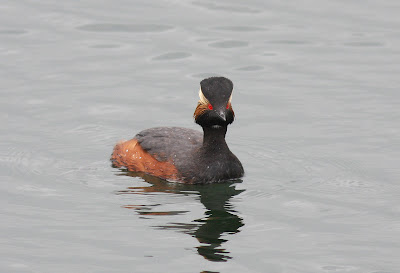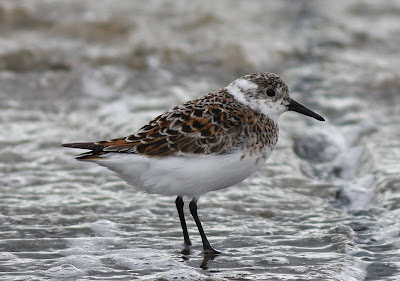A windy and showery day suddenly got a whole lot windier this afternoon. In fact trees were blown down near our home such was it's force and my wife had to rescue a girl who had been thrown from her wind spooked horse. Thankfully horse and rider were re-united with no real harm done. The wind and rain would mean hirundines and swifts would be feeding low over Farmoor Reservoir and with reports of at least three Red rumped Swallows being seen further south today I considered it worth the effort to head for the reservoir and try my luck.
The car park at the reservoir was deserted. Not one car. Battling against the wind but with the rain thankfully now abating I headed for the Causeway. No one else as far as I could see was daft enough to venture out in these weather conditions but looking out over the water there were as predicted a huge number of hirundines feeding above the waves. I counted at least 400 Swallows, 250 House Martins, and the occasional Sand Martin, joined by about 150 Common Swifts. There was no sign of a Red rumped Swallow however.
The car park at the reservoir was deserted. Not one car. Battling against the wind but with the rain thankfully now abating I headed for the Causeway. No one else as far as I could see was daft enough to venture out in these weather conditions but looking out over the water there were as predicted a huge number of hirundines feeding above the waves. I counted at least 400 Swallows, 250 House Martins, and the occasional Sand Martin, joined by about 150 Common Swifts. There was no sign of a Red rumped Swallow however.
The hirundines and swifts were in their element with especially the House Martins seemingly revelling in the almost gale force northeast wind. They would hurtle downwind alongside the Causeway and then turn and almost stall as they faced into the wind, hanging there almost stationary for a moment, then side slipping they would tack into the wind and fly low over the waves at speed before repeating the process all over again. A male Yellow Wagtail rose up from under the wave wall as I approached the Causeway and caught in the wind was blown rapidly downwind, just about in control of itself. A little further up the Causeway another Yellow Wagtail flew from under the shelter of the wall but more circumspect about the wind it flew low over the waves, passing me as it headed downwind. Hang on though. It's got a pale blue-grey head. I looked at it in my bins. No easy task in the wind which buffeted me mercilessly and made standing still far from easy. There was literally no hiding place for me on the exposed Causeway. The 'yellow' wagtail was a male 'Channel' Wagtail. The result of hybridisation between 'our' Yellow Wagtail and the Blue Headed Wagtail found across The Channel. It landed further down and I retreated back down the Causeway to get a closer look but it was having none of it and flew far off into the distance. Well that was the end of that little bit of excitement!
It was now touch and go if I ventured back up the Causeway but I resolved to make it as far as the birdwatching Hide which would at the very least give me some shelter from the vicious wind. As I got to the Hide I noticed that a number of Swallows were sheltering under the wave wall right by the Hide.They were the picture of dejection with rain sodden feathers and drooping wings. I feared the worst for them but after a while observing them from the Hide I realised that though they looked pretty fed up in the horrible conditions they were actively feeding on insects that they seized from the mossy concrete between the water's edge and the wave wall. The other side of the Causeway was far more sheltered if they needed to rest but they showed no interest and persisted in landing and feeding on the mossy concrete under the wave wall and exposed to the full force of the wind.
From the wind rattled Hide I could see them feeding on the mossy surfaces all the way up to the far end of the Causeway. This unusual behaviour gave me a great opportunity to get very close to the Swallows which would come right up to almost under the Hide, literally within three or four feet of me and I could look down on them from the sanctuary of the Hide un-noticed.
It was now touch and go if I ventured back up the Causeway but I resolved to make it as far as the birdwatching Hide which would at the very least give me some shelter from the vicious wind. As I got to the Hide I noticed that a number of Swallows were sheltering under the wave wall right by the Hide.They were the picture of dejection with rain sodden feathers and drooping wings. I feared the worst for them but after a while observing them from the Hide I realised that though they looked pretty fed up in the horrible conditions they were actively feeding on insects that they seized from the mossy concrete between the water's edge and the wave wall. The other side of the Causeway was far more sheltered if they needed to rest but they showed no interest and persisted in landing and feeding on the mossy concrete under the wave wall and exposed to the full force of the wind.
 |
| View from the Hide. You can just about see the Swallows on the mossy bank! |
My thoughts went back to my visit to southern Morocco in March and when I was watching Swallows completing their crossing of the Sahara on their way North. Inevitably I found myself reflecting on their current plight, reduced to scrabbling for food on the banks of a concrete reservoir in unseasonably foul weather and I wondered was it really worth all the effort?
 |
The above bird is intriguing as it is still in juvenile plumage. It seems improbable that it was bred this year so presumably it has not moulted into adult plumage in it's winter quarters |

































































